Reopening Toolkit
Do you need more information on safely reopening your organization to the public?
The following resources are provided to assist you in preparing your staff, volunteers, and facility to welcome back patrons. The links below are a combination of industry specific (museums, performing arts, etc.) and general information on a wide range of topics. Basic signage translated into several languages is also available.
Washington State Guidelines
Washington State Guidelines
Washington State Phase 2 and Phase 3 Museums and Similar Activities COVID-19 Requirements
Communicating to Your Patrons
Communicating to Your Patrons
We know that marketing and communications is a top concern right now—here, we’ve pulled some basic information on how to implement a communications strategy for restarting your cultural activities while adhering to Washington State public health safety reopening guidelines. This guide is specifically for organizations that have limited communications resources and need a place to start.
Your Communications Goal + Strategy
The goal is to clearly communicate how you are making it safe for your audience to attend your programs and return to your facility. Make sure your messaging is simple, clear, welcoming, and friendly. Be proactive in explaining what you’re doing to keep your staff and visitors healthy; let visitors know what to expect. This will help increase everyone’s confidence in participating in cultural activities again.
Sample language:
Please note: we included these safety measures purely as examples. They are neither required nor comprehensive—add or remove as appropriate for your organization.
“We can’t wait to welcome you back to [organization]! Our top priority is to keep you and our staff healthy and safe. Here’s what your visit will look like when we reopen on [date]:
- All of our staff will be wearing masks and gloves, and we’ll be cleaning surfaces like door handles frequently. They’ll be keeping their distance from you and others, but please wave and say hi!
- We’ll ask you to wear a mask, too. We have plenty of extras on hand in case you don’t have one or forget to bring it.
- The state of WA has asked everyone to maintain 6 ft. of distance when out in public, so we’ve put helpful markers on the floor in front of exhibits so you don’t have to worry about doing mental measuring.
Questions? Concerns? Just let us know! We’re available at [contact info].”
Understanding Your Audience’s Needs
Consider the specific audiences you serve and think about which tools are a fit for reaching them. If you have questions about how you can meet the needs of your audience, the best way to know is to ask! There are many free or affordable survey tools available to help you understand your audience’s needs and concerns. Here are a few we’ve used and like:
- Survey Monkey
- Google Forms
- Instagram Stories poll widget (limited functionality, but extremely simple to use if your organization is on Instagram!)
Recommended Tools + Communications Vehicles
Post to your website
If someone wants to know when you are going to reopen and what your safety policies are, your website will most likely be their first stop. If possible, add a page that is dedicated to your reopen efforts. Link to it directly from your homepage and make it easy to find.
Stay in touch via email updates
If you have an email list, this may be the most effective way to reach your community directly. If you need to reach many people, using an email marketing tool with an opt-out feature and list management capability will be the most effective. There are affordable or free tools available:
- MailChimp (email marketing tool of choice for 4Culture!)
- Constant Contact
Social media gets your message out
Social media is a big place and there’s a lot to know, but you can tailor it to your needs and bandwidth. If your organization is new to social media, we recommend picking either Facebook or Instagram to start out and focusing your efforts there. Here are some basic pointers for creating social media posts:
- Make sure every post has a visual of some kind, even if it’s simple. Text-only posts won’t stand out in a newsfeed.
- Keep your text short and snappy, but always include a link to more information.
- Commit to posting and checking it regularly. You don’t have to post every hour, or even every day! Just make sure you’re keeping people informed and answering any questions. Hootsuite and Sprout Social are both great tools that will let you schedule posts.
Try making a video!
Videos are becoming more and more popular on social media, and they’re easier than ever to make—just pull out your smart phone. Explore things like Instagram Stories and Facebook Live.
- A great start in video could be a step-by-step preview tour of what patrons will encounter when they visit your organization.
- Tip: apps like Clipomatic will add captions to your videos for you, helping make your videos accessible to all.
Need some help with all this?
Stay tuned—we’ll be offering free, virtual workshops with 4Culture Communications staff and community experts. Details coming soon.
Preparing your Staff and Volunteers
Preparing your Staff and Volunteers
As cultural organizations begin to reopen, decisions will need to be made about how to safeguard staff and volunteers. Here is a short, non-exhaustive list of resources around staff and volunteer training and maintaining health and safety in the workplace.
Staff and Volunteer Training
- Considerations for Museum Reopenings, American Alliance for Museums
This reopening guide suggests reviewing and updating workplace policies, (leave, telework, and compensation) consider if your organization needs to recruit, hire, orient, and properly train or retrain staff at all levels in operating, safety, and enhanced cleaning procedures, consider the emotional toll on your staff and take steps to promote wellness. - COVID-19 and Your Volunteer Program, American Association for Museum Volunteers
Here are some things you can do as a volunteer manager during the COVID-19 pandemic. - COVID-19 and Museum Volunteers, American Alliance for Museums
This article addresses issues about staying connected with volunteers, modifying their assignments, adapting to a smaller volunteer workforce, and cultivating new volunteers during the pandemic. - Considerations for Using In-Person Volunteers During COVID-19: Guidance for Nonprofit Organizations, Points of Light
This guide is designed to help organizations make decisions regarding their use of in-person volunteers during the COVID-19 pandemic and, if they decide to engage them, and how to do so as safely as possible. - The National Institute of Environmental Health Sciences (NIEHS) offers educational resources and tools intended for workers who are at greatest risk of exposure during the COVID-19 pandemic, including a training on protecting oneself from COVID-19 in the workplace.
- How to Protect Yourself & Others, Center for Disease Control and Prevention (CDC)
Includes the most recent Information about how COVID-19 spreads and what to do. - Coronavirus/COVID-19: What it means for our volunteers, American Association for Museum Volunteers
Sample plan and template for a volunteer plan.
Responding to COVID-19 in the workplace
- OSHA Guidance on Preparing Workplaces for COVID-19, U.S. Department of Labor’s Occupational Safety and Health Administration (OSHA)
Developed in collaboration with the U.S. Department of Health and Human Services to help employers respond in the event of coronavirus in the workplace. - COVID-19 Webpage, U.S. Department of Labor’s Occupational Safety and Health Administration (OSHA)
Provides infection prevention information specifically for employers and workers, refer to this page for the most recent information.
Protocols for dealing with patrons violating social distancing guidelines
- COVID-19 and Unrecognized Realities Experienced by Black People, Public Health Insider.
This article discusses that many members of the Black community are concerned that wearing face coverings may lead to dangerous and harmful encounters with law enforcement or other community members. - Anti-stigma resources, King County Public Health
Resources include where to report discrimination and understanding workplace rights and responsibilities.
Health checks and what to do if a staff member is sick
- OSHA Guidance on Preparing Workplaces for COVID-19, U.S. Department of Labor’s Occupational Safety and Health Administration (OSHA)
Ideas for developing policies and procedures for prompt identification and isolation of sick people, if appropriate. - CDC’s General Business FAQs, Center for Disease Control and Prevention (CDC)
What to do if there are suspected or confirmed cases of COVID-19 in the workplace and how to reduce the spread. - Guidance for Daily COVID-19 Screening of Staff and Visitors, Washington State Department of Health
The Washington State Department of Health asks that all employers use this guidance to help prevent the spread of CoVID-19 by screening staff and visitors daily. - COVID-19 Screening Tool, Center for Disease Control and Prevention (CDC)
If you think you have COVID-19, use this screening tool to assess your symptoms. - Steps to take if you are sick with COVID-19, Center for Disease Control and Prevention (CDC)
Screening tool and guidance for steps to take if you are sick with COVID-19 or think you may be infected with coronavirus. - COVID-19 employee symptom attestation, University of Washington
An example of daily attestation and if symptomatic, steps for the employer and employee to follow. - Revised Enforcement Guidance for Recording Cases of Coronavirus Disease 2019, U.S. Department of Labor’s Occupational Safety and Health Administration (OSHA)
Explains when employers are responsible for recording cases of COVID-19. - Updated Interim Enforcement Response Plan for Coronavirus Disease 2019 (COVID-19), U.S. Department of Labor’s Occupational Safety and Health Administration (OSHA)
Instructions and guidance for handling COVID-19-related complaints, referrals, and severe illness reports.
Preparing your Facility
Preparing your Facility
This section consists of short-listed resources for the reopening of facilities, from supply resources and cleaning procedures to the design of your building in response to social distancing.
Supply Resources
- Seattle Protects, City of Seattle.
A marketplace for cloth face coverings for Seattleites during the COVID-19 pandemic. - Disinfect Connect, linking at-risk organizations with local distilleries producing disinfectant.
- PPE Supply Sources, Impact Washington.
A short list of places where Personal Protective Equipment (PPE) supplies can be ordered or sold. - COVID-19 Response Products, Rainier Industries
Graphics, signage, shields and more for businesses and workplaces. - Strategies to Optimize the Supply of PPE and Equipment, Centers for Disease Control and Prevention (CDC)
Design and Best Practices
- COVID-19 Design Guide, Mackenzie.
This guide provides a series of illustrations of how the built environment can be adapted in response to the current pandemic. - Sample reopening plans, American Alliance of Museums.
Submitted by individual institutions, these plans provide a resource to other museums planning their own reopen. - Sneeze Guards & Employee Protection Solutions, Commercial Plastics Corp.
Located in Seattle and serves the Pacific Northwest. Plastic guards are a potential solution for protecting staff and visitors in areas of frequent visitor interaction. - Understanding the impact of social distancing on occupancy, U.S. Fire Administration.
This page provides considerations for authorities having jurisdiction (AHJs) and building managers when social distancing during the COVID-19 pandemic.
Guidelines for Sanitizing Facility and Daily Cleaning Procedures
- Safe Cleaning and Disinfection Guidance for Public Spaces, Washington State Department of Health.
This guidance describes safe cleaning and disinfection practices for businesses, parks and other public spaces to ensure cleanliness and safety. - Guidance for Cleaning and Disinfecting, Centers for Disease Control and Prevention (CDC).
This guidance ensures the cleanliness and safety of public spaces, workplaces, and more. Additional guidance and flow chart are available in the Reopening Decision Tool. - Cleaning and Disinfecting your Facility, Centers for Disease Control and Prevention (CDC).
A factsheet outlining everyday steps, steps when an employee is sick, and considerations for employers. - Managing collections care during pandemics, American Alliance of Museums.
Helpful tips to care for collections during COVID-19.
Multi-language signage
Multi-language signage
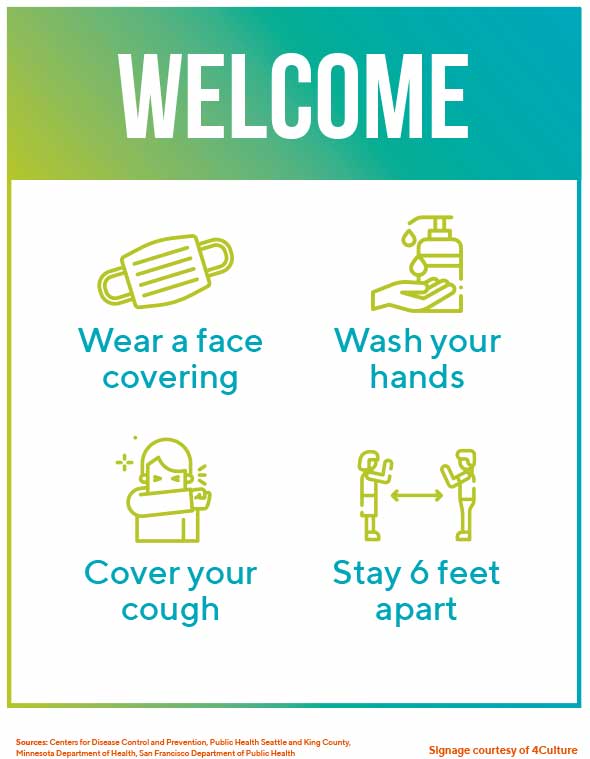
Welcome – Wear a face covering, Wash your hands, Cover your cough, Stay 6 feet apart.
Printable PDF, 8.5″W x 11″H
Additional Languages: Punjabi, Spanish, Vietnamese, Russian, Somali, Simplified Chinese, Korean, Ukrainian, and Amharic.
Download a google sheets spreadsheet of translated text to copy and paste in your own materials.
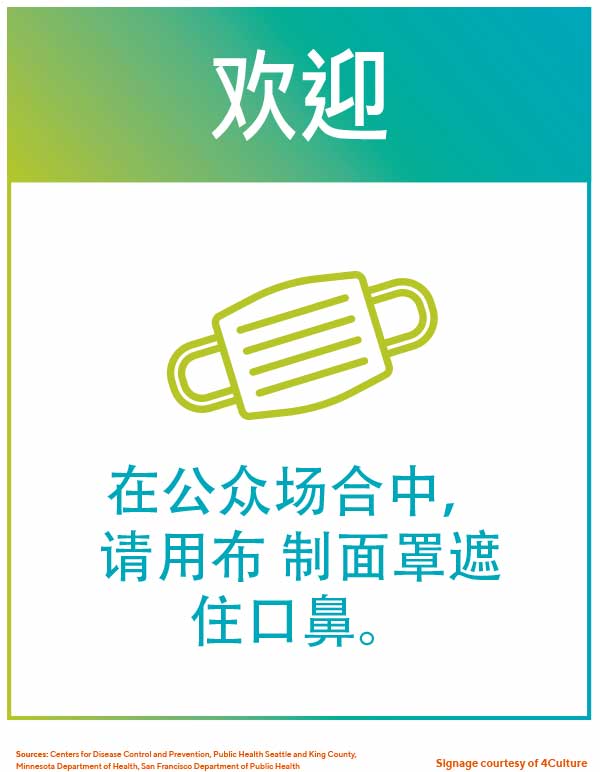
Welcome – When in public, wear a cloth face covering over your nose and mouth.
Printable PDF, 8.5″W x 11″H
Additional Languages: Punjabi, Spanish, Vietnamese, Russian, Somali, Simplified Chinese, Korean, Ukrainian, and Amharic.
Download a google sheets spreadsheet of translated text to copy and paste in your own materials.
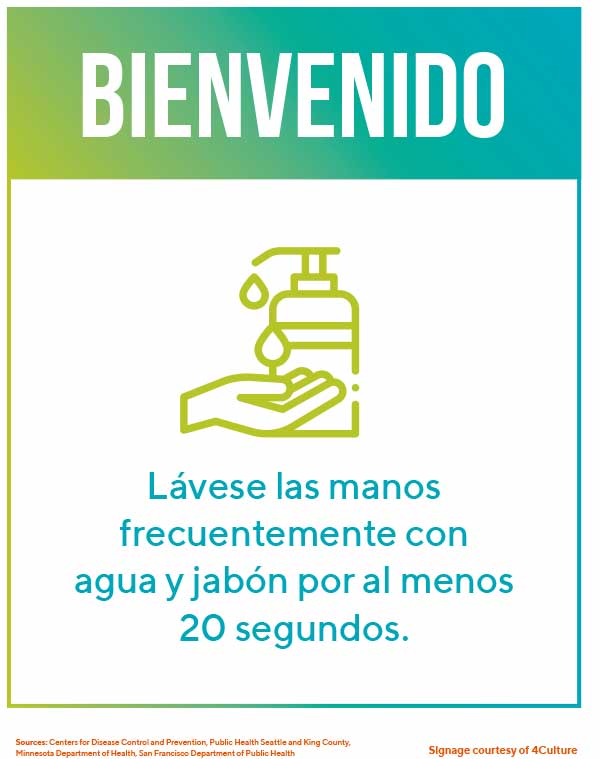
Welcome – Wash your hands often with soap and water for at least 20 seconds.
Printable PDF, 8.5″W x 11″H
Additional Languages: Punjabi, Spanish, Vietnamese, Russian, Somali, Simplified Chinese, Korean, Ukrainian, and Amharic.
Download a google sheets spreadsheet of translated text to copy and paste in your own materials.
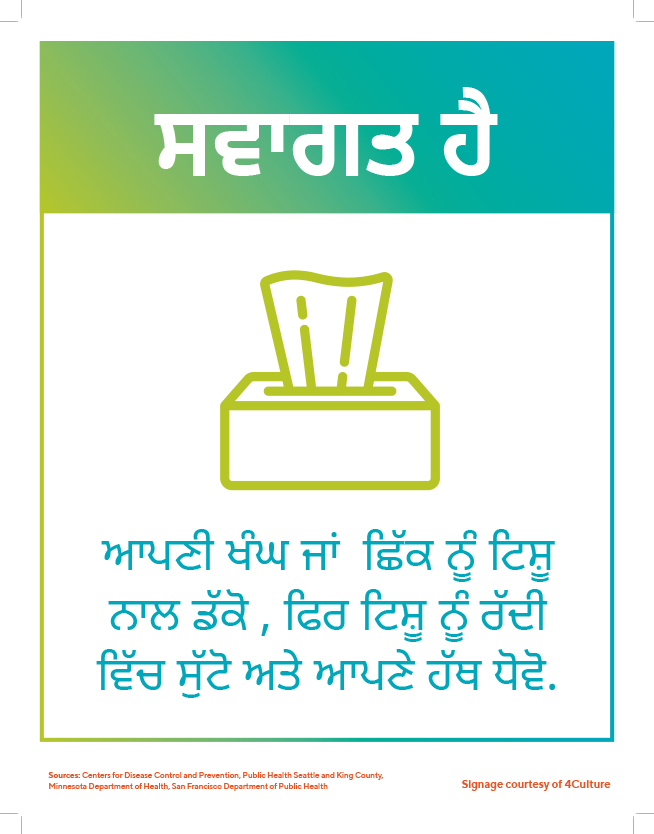
Welcome – Cover your cough or sneeze with a tissue, then throw the tissue in the trash and wash your hands.
Printable PDF, 8.5″W x 11″H
Additional Languages: Punjabi, Spanish, Vietnamese, Russian, Somali, Simplified Chinese, Korean, Ukrainian, and Amharic.
Download a google sheets spreadsheet of translated text to copy and paste in your own materials.
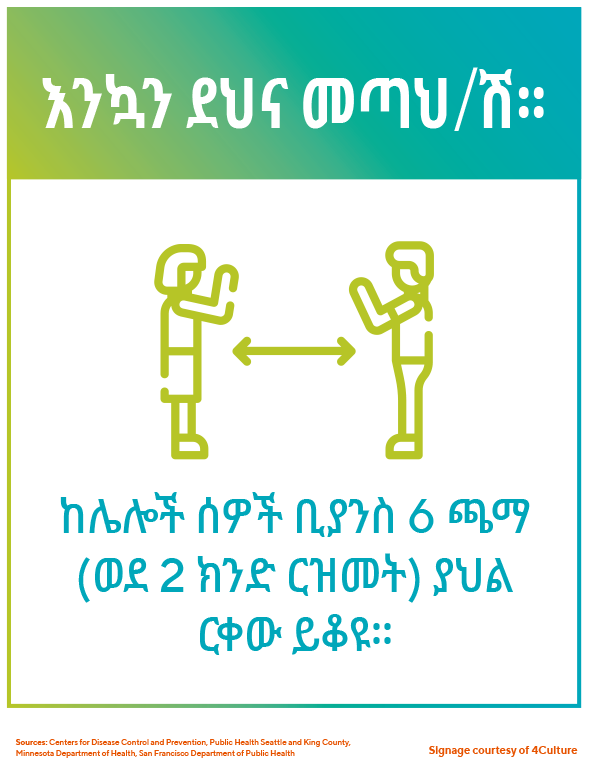
Welcome – Stay at least 6 feet (about 2 arms’ length) from other.
Printable PDF, 8.5″W x 11″H
Additional Languages: Punjabi, Spanish, Vietnamese, Russian, Somali, Simplified Chinese, Korean, Ukrainian, and Amharic.
Download a google sheets spreadsheet of translated text to copy and paste in your own materials.
